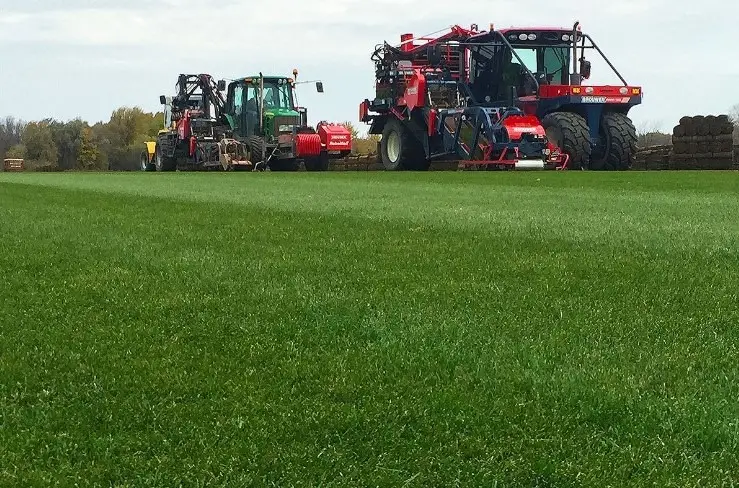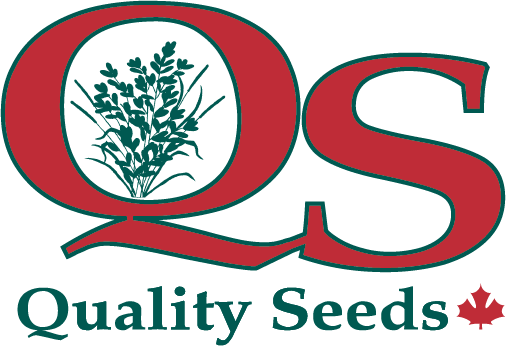Serious About Sod – Fall 2024

- Factors Affecting Winter Hardiness
- Rust in Turf Grass
- What Are Good Starting Soil Test Nutrient Levels?
1. Factors Affecting Winter Hardiness
Over the past few years, I have observed dead patches in over-wintered sod which was not caused by disease. This problem is more prevalent in winters where there have been multiple freezing and thawing cycles with poor snow cover. The following include factors that affect winter hardiness:
a) Variety Selection: Variety selection can be a factor in the winter survivability of nursery sod. Most if not all seed companies are constantly testing new varieties to improve winter-hardiness, disease resistance, drought tolerance, and other desirable qualities. Where winter injury is a concern, it is important to discuss this issue with your seed supplier.
b) Sod Nutrition: Research done at the University of Guelph has shown that the late fall application of nitrogen does improve winter-hardiness of Kentucky bluegrass. Where winter injury has occurred in Kentucky bluegrass, I have found, from soil testing, that low levels of potassium, zinc, magnesium, and boron seem to be linked to this problem. I have also seen that low levels of these nutrients can affect the winter hardiness of perennial crops such as alfalfa, apples, peaches, strawberries, asparagus, and raspberries.
Late fall applications of a fertilizer containing potassium and nitrogen with at least 2% magnesium and 1% zinc will greatly improve winter-hardiness in bluegrass where soil levels of these are moderate or low.
c) Planting Date: Seeding in mid-August to early September will help increase winter-hardiness. Later seeding will result in late germination, poor root development and poor crown strength, which will result in the planting being less hardy.
d) Root Development: Larger root mass will result in sod which is less prone to frost heaving. A larger root mass produces a larger crown with more food reserves, producing a more winter-hardy sod. Where frost-heaving has been a problem, an application of TruPhos Advance (Platinum) @ 0.67 L/ac or Terra Drive @ 1 L/ac will greatly increase root mass. This application should be made starting when the new seeding is 1 to 2 inches in height in mid-September.
2. Rust in Turf Grass
Rust is beginning to appear on grass in apple orchards, fence rows, and some sod fields. Rust is caused by a fungus which requires two hosts, one being a woody species such as barberry or buckhorn, and the other being grass.
Rust attacks barberry and buckhorn in the early spring, producing spores which during the summer can infect grass. Infections on grass produces pustules, which release more spores, infecting more grass tissue.
Usually rust begins to appear once the grass comes under stress caused by drought or poor fertility. Once infections occur, high humidity, dews, frequent rain, and fog will help to promote the spread of rust. Rust can be controlled by proper fertility and mowing. Maintaining a balanced fertility program to avoid nutrient stress, and increasing the mowing height and frequency will reduce the severity of rust. Fungicides in the strobilurin family, such as Insignia EG (pyraclostrobin) will control rust. Resistant varieties of Kentucky bluegrass and Perennial Ryegrass are available.
3. What Are Good Starting Soil Test Nutrient Levels?
I have been asked many times as to what are considered good soil test nutrient levels for nursery sod. The following are the levels I would consider good in an A & L soil test:
a) Phosphorus: 25-30 ppm is considered as a good soil reading. If phosphorus is very high, a zinc deficiency can be induced.
b) Potassium: 150 ppm or higher is considered a good soil reading. Nursery sod crop removal of this nutrient is very high.
c) Magnesium: The percentage base saturation should range from 12-20 ppm. A range of 11-13 ppm is considered very good for a clay loam soil, whereas for lighter soils such as a sandy loam, the range should be 16-20 ppm. A silt loam should be 13-15 ppm. It is difficult at times to increase the base saturation of magnesium, especially in soils with a high calcium content.
d) Calcium: The ideal base saturation of this nutrient is between 65-80% and can be increased by the addition of lime to the soil where required.
e) Sodium: The level of sodium in the soil should be less than 40 ppm. High sodium levels in the soil can reduce nursery sod growth, and at high levels, can cause die-back. Sodium levels can be brought down with an application of gypsum.
f) Sulfur: The level of sulfur should be at least 14 ppm or higher in the soil. An adequate level of sulfur is determined by the soil type, the organic level in the soil, and by the cation exchange capacity (CEC) of the soil. Sulfur can be leached out of the soil by heavy rainfall, especially in lighter soils, and should be applied in low amounts in each fertilizer application on nursery sod.
g) Zinc: Adequate levels are those above 5 ppm.
h) Manganese: Adequate levels are between 30-35 ppm or higher. Manganese helps promote lateral root development. Adequate Manganese levels will increase sod strength and liftability.
i) Iron: Levels around 40 ppm are considered to be very good. In Ontario, most fields are very high in Iron. Iron gives Kentucky bluegrass the nice dark green colour. Foliar application can really green up a sod field.
j) Copper: Levels at 1.5 ppm are considered adequate, although levels above 1.5 ppm can be beneficial in disease suppression.
k) Boron: The level considered good for boron should be above 1 ppm. Boron is highly leachable, especially in lighter sandy loam and silt loam soils. A small amount should be applied in with the fertilizer blend during the growing season.
l) Aluminum: Aluminum levels ideally should be below 500 ppm. High Aluminum levels can reduce phosphorus availability by tying up phosphorus in an unavailable form. High levels of aluminum can be reduced by applications of gypsum.
In conclusion, the levels suggested are not always obtainable with the application of a fertilizer blend. These levels are ideal readings for a nursery sod soil test. Nursery sod harvest extracts around 240 lbs/acre of potassium and large amounts of potassium are required before seeding. During the growing season, with each application of fertilizer, 20 lbs per acre of potassium should be in the blend, and Nitrogen rates should be around 50-60 lbs per acre. A balanced fertilizer program based on a soil test will promote a healthy, productive nursery sod field.
If you have any questions or any sod issues, please call me at 705-791-9321.
Joe Uyenaka, BSc (Agr), CCASenior Crop AgronomistNutriAg
